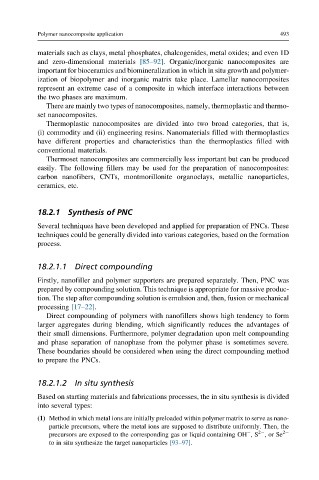Page 540 - Polymer-based Nanocomposites for Energy and Environmental Applications
P. 540
Polymer nanocomposite application 493
materials such as clays, metal phosphates, chalcogenides, metal oxides; and even 1D
and zero-dimensional materials [85–92]. Organic/inorganic nanocomposites are
important for bioceramics and biomineralization in which in situ growth and polymer-
ization of biopolymer and inorganic matrix take place. Lamellar nanocomposites
represent an extreme case of a composite in which interface interactions between
the two phases are maximum.
There are mainly two types of nanocomposites, namely, thermoplastic and thermo-
set nanocomposites.
Thermoplastic nanocomposites are divided into two broad categories, that is,
(i) commodity and (ii) engineering resins. Nanomaterials filled with thermoplastics
have different properties and characteristics than the thermoplastics filled with
conventional materials.
Thermoset nanocomposites are commercially less important but can be produced
easily. The following fillers may be used for the preparation of nanocomposites:
carbon nanofibers, CNTs, montmorillonite organoclays, metallic nanoparticles,
ceramics, etc.
18.2.1 Synthesis of PNC
Several techniques have been developed and applied for preparation of PNCs. These
techniques could be generally divided into various categories, based on the formation
process.
18.2.1.1 Direct compounding
Firstly, nanofiller and polymer supporters are prepared separately. Then, PNC was
prepared by compounding solution. This technique is appropriate for massive produc-
tion. The step after compounding solution is emulsion and, then, fusion or mechanical
processing [17–22].
Direct compounding of polymers with nanofillers shows high tendency to form
larger aggregates during blending, which significantly reduces the advantages of
their small dimensions. Furthermore, polymer degradation upon melt compounding
and phase separation of nanophase from the polymer phase is sometimes severe.
These boundaries should be considered when using the direct compounding method
to prepare the PNCs.
18.2.1.2 In situ synthesis
Based on starting materials and fabrications processes, the in situ synthesis is divided
into several types:
(1) Method in which metal ions are initially preloaded within polymer matrix to serve as nano-
particle precursors, where the metal ions are supposed to distribute uniformly. Then, the
2
precursors are exposed to the corresponding gas or liquid containing OH ,S ,or Se 2
to in situ synthesize the target nanoparticles [93–97].

